Although demand for recycled plastics continues to accelerate—driven, in part, by commitments from brand owners to incorporate recycled content into their products—the US Environmental Protection Agency indicates that the US recycling rate remains at around 9 percent.1 Together, several factors limit US recycling: consumer behavior, lack of access to recycling, the sortation of challenging plastics, and insufficient recycling capacity.2
Here, we focus on an important opportunity to resolve challenges regarding the sortation of so-called challenging plastics, which refers to non-bottle packaging materials such as films and flexible items, foams, and small-format items. Films, in particular, are sought by recyclers for use as feedstock for new technologies called “advanced recycling.”3 Although significant quantities of challenging plastics are available from the waste-management industry, only a limited volume is actually recycled today because of market disconnect: the quality of material available does not meet the input requirements for recyclers.
This article outlines an opportunity to deploy a new generation of secondary sorting facilities, also called feedstock preparation facilities (FPFs), to resolve this market disconnect and enable a significant step forward in US plastic recycling. Our conclusion is that demand for recycled plastics is strong, there are large volumes of untapped feedstock available to meet this demand, and price premiums for recycled material make the economics attractive for the entire value chain to invest to collect and process this material to produce high-quality circular plastics.
Recycling rates for post-use plastic packaging are not equal
Today, there is a wide range in the recycling rates of different plastics and forms of plastic. Plastic bottles and other large, rigid packaging forms—typically polyethylene terephthalate (PET) and high-density polyethylene (HDPE)—have the highest recycling rates of all plastics at 20 percent or more (Exhibit 1).

PET and HDPE bottles (for example, water bottles, milk jugs, and shampoo bottles) are widely accepted in household curbside recycling programs alongside paper, metal, and glass. Consequently, these bottles have stable systems in place for recovery, such as being easily sorted in material recycling facilities (MRFs), which can manage single-stream recyclables with automated sorters.
Other packaging segments, such as films, bags, and other food service items, which are largely made from polyethylene (PE), have recycling rates of less than 10 percent. Films and flexibles have low acceptance rates in curbside or residential programs and are mostly recovered by commercial back-of-store collection. Of the approximately 35 million metric tons (MT) of post-use plastics generated every year in the United States, these challenging forms of plastic packaging—such as PE films, multilayered packaging, thermoforms, foams, and small rigids—account for around eight metric tons per annum (MTPA). This plastic could serve as feedstock for recyclers but today remains largely untapped.
Market disconnect for films and flexibles
There is strong demand for recycled plastics, especially from consumer packaged goods (CPG) companies that need to use post-use plastics to meet recycling commitments. On this point, many CPG companies have committed to shifting 15 to 50 percent of their portfolios to be recycled plastics—in some cases, as soon as 2025 or 2030.4
This demand is evidenced by premiums for recycled plastics—especially for high-quality grades used in packaging, such as natural HDPE. Despite this demand, low recycling rates for films and flexible-plastic material persist, and many programs do not collect these materials. Of the approximately 500 MRFs in the United States today, 20 to 30 percent have some capability to handle plastic films. These MRFs could produce what is known as a “MRF film bale”; however, the majority choose not to because of a perceived lack of an end market.
The disconnect is likely due to the quality of post-use plastic bales. Today, the quality of MRF film bales is typically low. Some are composed of 50 to 70 percent PE or polypropylene (PP); 10 to 20 percent other undesired plastics, such as PET or polyvinyl chloride (PVC); and 10 to 30 percent nonplastic materials, such as paper, metal, or food residues. The composition of the bales is also highly inconsistent, with high variability over time and by source, making it difficult to use them in downstream processing.
Downstream recyclers, even in more flexible advanced-recycling processes, require purity levels of 80 to 90 percent or higher. Mechanical recyclers require even higher-quality plastics, such as film grades of B or A/A+ in which clear PE is required to be more than 95 or 99 percent pure, respectively.
The quality and volume mismatch between supply (MRFs) and demand (advanced recyclers or CPGs) has resulted in market disconnect. On the one hand, there are plenty of unused low-quality flexible bales that go to landfills; on the other hand, there is limited feedstock to scale advanced recycling (Exhibit 2).

How to increase post-use plastics recovery
To resolve the market disconnects caused by mismatched quality of feedstock, the plastics recycling industry can invest in FPFs to upgrade the quality of bales. FPFs could serve to aggregate and upgrade plastic waste to meet the specifications of downstream processors. Premiums for recycled plastic enable reinvestment-level returns at each step. Building out this system will require collaboration between the (advanced) recycling industry and the waste industry. This proposed solution is outlined in more detail below.
Cleaning the waste stream by removing contaminants
To improve the quality of feedstock, the plastics recycling industry could invest in FPFs to increase polyolefin content to meet the specifications for advanced recycling and aggregate volume from MRFs to feed advanced recyclers. FPFs can also deploy sorters—for example, ballistics, eddy current, magnet, or optical—to remove other plastics and contaminants and can tailor the physical representation of the feedstock to the needs of each recycling facility, such as deploying shredding, densification, or extrusion to alter the physical form of feedstock to meet the requirements of specific recycling facilities.5
Moving forward, FPFs can redirect MRF films that would otherwise end up in a landfill, and the 20 to 30 percent of MRFs able to handle flexible films can begin to deploy their capabilities. After these MRF capacities are fully used, the industry can invest in additional MRF upgrades, such as new ballistic or optical sorters, to accept more films from residential and small commercial sources.
These changes require additional investment and create tiers of costs by source and method of recovery (Exhibit 3). Initially, low-cost post-use film can be recovered from large and midsize commercial sources through front-of-store consumer drop-offs and back-of-store baling. Construction of FPFs to upgrade films from MRFs would represent the next tier of cost. Other costs could stem from upgrading MRFs and building FPFs. Finally, some sources, such as rural locations, have no access to recycling, and providing access would require larger investments, such as purchasing new trucks or developing MRFs.

Supporting additional sortation costs through premiums for recycled plastic
Additional sortation would incur higher costs for post-use plastic feedstock than advanced recyclers have historically paid. Our research shows that the waste-management industry could supply films from commercial sources at less than $200 per MT, but demand increases could raise costs up to $300 to $500 per MT as more expensive tiers of plastic waste are required to meet demand (see sidebar “How feedstock preparation facilities can succeed”).
Over the past three years, however, the premium paid for recycled plastic compared with virgin material has been high—more than $1,500 per MT—and is more than enough to cover the additional sortation costs described above. These premiums can be passed across the value chain to encourage investment in upgrading the quality of bales.
Supporting collaboration between waste players and chemical players
The plastics recycling industry (including chemical producers) and waste-management industry can work together to scale recycling of these challenging plastics. Chemical players have the downstream assets and product portfolios; waste-management companies own the post-use plastic materials and are best positioned to deploy sortation technologies. To some extent, these companies are able to deploy such technologies today, though they do not yet have the economic incentives to do so.
The chemical industry, in particular, can help signal a strong and growing demand for feedstock and can help to finance the mobilization of the waste-management industry, through either direct capital investment or offtake arrangements. This could help build confidence with the waste-management industry, which could then encourage further investment. Beyond just chemical producers and waste management, support from consumers, packaging converters, brand owners, and policy makers will be required to ensure success.
In the years to come, we expect continued demand for recycled plastics. By tapping into new segments of plastic waste, brands will be able to achieve their commitments on recycled material, enabled by advanced recyclers and supported by price premiums which allow investment across the value chain. These circumstances present an unprecedented opportunity for waste collectors and advanced recyclers to jointly (and profitably) invest to drive a step change in North American recycling rates.


